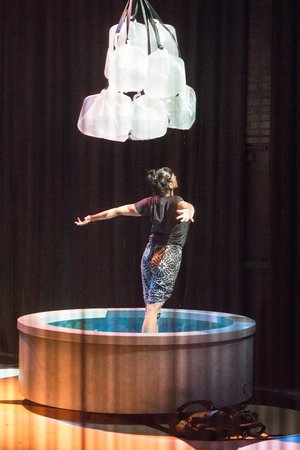Who/What/When/Where defines you? — Anthropic Traces
Crow’s Theatre’s Anthropic Traces is a series of stand alone stories that have found themselves tied to one another through concepts surrounding travel and acceptance. Produced by Balancing on the Edge in association with A Girl in the Sky Productions and Thin Edge New Music Collective, Anthropic Traces brings together circus, dance, theatre, mask, live music, and projection art.
The piece as a whole was one of the most gorgeous uses of projection mapping I have seen. The projections were used to transport audiences to completely different worlds, one of them being under the sea. There was also a gorgeous moment with the gong; as the instrument was hit the lights would ripple outwards until the sound completed.
As an anthology, characters appear for brief moments as the world moves around them, like a conversation I was simply eavesdropping in on. It didn’t feel like audiences were meant to be fully immersed in the story world, but observing the multitude of faces and bodies to eventually determine what relationships you’re meant to focus on.
Audiences are taken first through a busy airport, where a couple is detained for no apparent reason, a young girl loses her toy as she is rushed by her mother, lovers meet and depart, and a custodian cleans up after them all. Themes of identity and loss are explored in relation to water and fluidity. We learn about performer Amy Hull’s move across the country and how this has affected her sense of self, as she speaks about the fluidity and connections she feels to the lakes and oceans in her monologue, illustrating her Indigenous identity. There is a gorgeous underwater scene towards the end where a string of jerry-cans get lifted out of a pool, a visceral image representing melting icebergs. Artists are seen spinning, swimming, and climbing through the water as the jerry-cans create a striking and unpredictable auditory experience for the movement of water.
We continue to observe various relationships struggling to build and bond over man-made borders and distances. One scene depicts two lovers as they navigate the configurations of their romance and home. Boxes are used to build walls and various structures, elements of circus acts like juggling and contortion create an exceptional physical and evocative tone.
The word anthropic is defined as informing or concerning the existence of human life, or simply, caused by human beings—anthropogenic. To me, Anthropic Traces is about the water, in which it concerns: movement, borders, and gatekeeping. Through war, displacement, and governing bodies, many of the characters experience displacement. The piece has so many different stories for all walks of life to relate to. Though it was not for me to speak back to, I still wanted to speak about the work with friends.
Immediately after the show, I sat with audience member Anusha Bhadra, along with Hull to unpack what we had witnessed. As marginalized people, and some of us immigrants, I wanted to take some time to reflect upon the emotions the piece brought up for us.
If you’re also a third culture kid or a person of colour, then maybe you know how this conversation went. If you are not, the evening resulted in an hour long conversation dancing at the intersections of language, belonging, and estrangement.
Bhadra shared with us a little bit into her life as an immigrant. Originally from Kolkata, India, she lived in many different countries before landing in Canada. She mentioned how sometimes it feels hard to be a “good Bengali” as she is unable to speak one of her native languages.
Hull spoke about herself and her relations to the water, the land and the state. During her monologue in the first act, Hull mentions that her Mi’kmaq identity was “governmentally stripped from her ” when she moved out of Newfoundland. In conversation, we spoke about the sorts of gatekeeping that can happen from community members as well. The word ‘pretendian’ refers to non-Indigenous people who claim Indigenous identity without the lived experience, or any cultural/historical ties to the community. With the uprising of these folks, there came others who have made it their responsibility to call out those that are taking away opportunities and resources from Indigenous peoples.
But who gets to define who is and is not a part of a particular culture? As an African Canadian, I cannot speak to who a true Indigenous person is, but as a third culture kid, I too have been questioned about the authenticity of my identity/culture. I can empathize with where people are coming from, wanting to call-out those that are pretending to be a part of your culture. And I understand this kind of gatekeeping is done in order to protect the community from harm, but there needs to be space within the community for those that do not necessarily fit perfectly within the mandates.
We need to understand our identities like water, and that they are fluid. The process of re-entering, and re-emerging can look differently for everyone.
Anthropic Traces, produced by Balancing on the Edge in association with A Girl in the Sky Productions and Thin Edge New Music Collective, ran at Crow’s Theatre from July 27-31, 2022.


